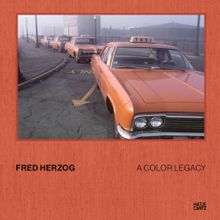| |||||||||||||||||||||||||
PHOTOGRAPHY MONOGRAPHS
|
|
STATUS: Forthcoming | 1/13/2026 This title is not yet published in the U.S. To pre-order or receive notice when the book is available, please email orders @ artbook.com |
 Fred Herzog: Black and White
Fred Herzog: Black and White
Published by Hatje Cantz.
Text by Geoff Dyer.
Fred Herzog roamed the streets of Vancouver to create a portrait of his adopted hometown in chance scenarios and spontaneous acts of perception. Today his work is among the most important examples of early color photography. But Herzog did not decide to work almost exclusively with Kodachrome slide color film until the late 1950s. Fred Herzog: Black and White is the first appreciation of a lesser-known facet of the photographer's work. Complementing the landmark publication of Modern Color in 2017, the volume brings together his sumptuous arrangements of light and shadow, and moments of life outside the city. The early black-and-white photographs evoke a sense of melancholy, not nostalgia, showing that the appeal of Herzog's work lies in his flair for condensing a psychological state.
Fred Herzog (1930–2019) arrived in Vancouver from Germany in 1953. Professionally employed as a medical photographer, he spent his evenings and weekends photographing the city and its inhabitants in vibrant color. Though he was working prolifically from the 1950s on, Herzog was relatively unknown until a major retrospective at the Vancouver Art Gallery in 2007 brought his work to a wider public. Digital inkjet printing enabled Herzog to finally make satisfactory prints from his slides and exhibit his important early color street photography.
PUBLISHER
Hatje Cantz
BOOK FORMAT
Clth, 9 x 9 in. / 128 pgs / 70 bw.
PUBLISHING STATUS
Pub Date 12/27/2022
Active
DISTRIBUTION
D.A.P. Exclusive
Catalog: FALL 2022 p. 14
PRODUCT DETAILS
ISBN 9783775753227 TRADE
List Price: $50.00 CAD $70.00
AVAILABILITY
In stock
in stock $50.00 Free Shipping UPS GROUND IN THE CONTINENTAL U.S. |
 Fred Herzog: Modern Color
Fred Herzog: Modern Color
Published by Hatje Cantz.
Text by David Campany, Hans-Michael Koetzle, Jeff Wall.
Fred Herzog is best known for his unusual use of color photography in the 1950s and 1960s, a time when art photography was almost exclusively associated with black-and-white imagery. In this respect, his photographs can be seen as prefiguring the New Color photographers of the 1970s. The Canadian photographer worked largely with Kodachrome slide film for over 50 years, and only in the past decade has technology allowed him to make archival pigment prints that match the exceptional color and intensity of the Kodachrome slide, making this an excellent time to reevaluate and reexamine his work.
This book brings together over 230 images, many never before reproduced, and features essays by acclaimed authors David Campany, Hans-Michael Koetzle and artist Jeff Wall. Fred Herzog is the most comprehensive publication on this important photographer to date.
Fred Herzog (born 1930 in Germany) arrived in Vancouver in 1953. Professionally employed as a medical photographer, he spent his evenings and weekends photographing the city and its inhabitants in vibrant color. Though he has been working prolifically since the 1950s, Herzog was relatively unknown until a major retrospective at the Vancouver Art Gallery in 2007 brought his work to a wider public. Digital inkjet printing has enabled Herzog to finally satisfactorily make prints from his slides and exhibit his important early color street photography.
PUBLISHER
Hatje Cantz
BOOK FORMAT
Hardcover, 10.5 x 10.5 in. / 320 pgs / 230 color.
PUBLISHING STATUS
Pub Date 2/28/2017
Active
DISTRIBUTION
D.A.P. Exclusive
Catalog: SPRING 2017 p. 37
PRODUCT DETAILS
ISBN 9783775741811 TRADE
List Price: $60.00 CAD $92.00
AVAILABILITY
In stock
in stock $60.00 Free Shipping UPS GROUND IN THE CONTINENTAL U.S. |
 Fred Herzog: Photographs
Fred Herzog: Photographs
Published by Hatje Cantz.
Preface by Felix Hoffmann. Text by Claudia Gochmann.
PUBLISHER
Hatje Cantz
BOOK FORMAT
Hardcover, 7.5 x 8.5 in. / 192 pgs / 92 color / 6 bw.
PUBLISHING STATUS
Pub Date 4/30/2011
Out of print
DISTRIBUTION
D.A.P. Exclusive
Catalog: SPRING 2011 p. 92
PRODUCT DETAILS
ISBN 9783775728119 TRADE
List Price: $45.00 CAD $55.00
AVAILABILITY
Not available
STATUS: Out of print | 00/00/00 For assistance locating a copy, please see our list of recommended out of print specialists |
